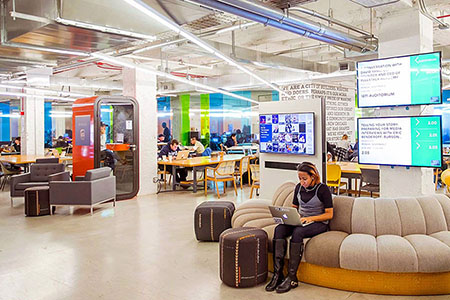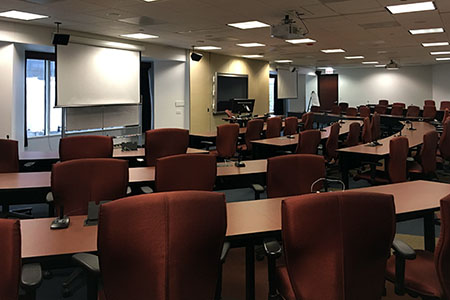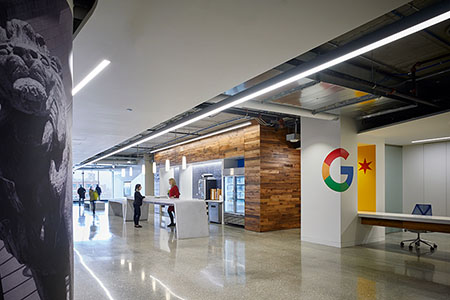
How Windy City became Cyber City
A strategic plan developed by government and the business community has drawn tech workers and tech companies back to the Midwest. The bigger payoff – creating thousands of high-paying jobs over the next decade.
By Howard Tullman
4-Sep-19 – With the opening seven years ago of 1871, the tech incubator located in Chicago’s Merchandise Mart, the business and investment community led by Chicago’s then mayor, Rahm Emanuel, with initial funding by J.B. Pritzker, now Governor of Illinois, set out to change the city’s tech image.
The first order of business was to destroy the misleading and self-serving Midwest “flyover” narrative promoted for years by the media at the behest of various bi-coastal venture capitalists. The second was to move aggressively to put Chicago’s tech and entrepreneurial startup scene on the national – and ultimately, global – map.
 | By 2016, 1871 (left) was recognized by UBI Global as the number one university-affiliated incubator in the world and Chicago was increasingly ranked among the top ten technology ecosystems globally. |
In the same period, the tech sector as a share of Chicago’s economy grew from approximately three percent to almost 14 percent, while creating more than 165,000 new jobs. The city also led the United States for five consecutive years in relocations of major corporate headquarters.
By 2017, more than nine million square feet of space in the central business district was occupied by technology firms. Even more importantly from a talent perspective, over roughly the same period, Chicago substantially led the nation in the growth of the portion of its population who were college-educated millennials.
Before his term ended, Mayor Emanuel also launched two other important growth and tech-centric education initiatives for the city – Discovery Partners Institute, a multi-university collaborative research institute, and P33, a forward-planning initiative that assembled a broad working group of civic, tech, and business leaders. Both DPI and P33 are intended to build on the substantial progress to date and to develop the road map for Chicago’s future as a major center for technology discovery, innovation, and education.
(Right) Classroom at Discovery Partners Institute, located at 200 South Wacker Drive. (Click on images to view larger versions.)
|  |
Central to both undertakings will be the city’s educational institutions. Chicago today has more colleges and universities within its geographic boundaries than any city other than Boston, with well over 60,000 college students in the downtown area.
But it may well be that Emanuel’s most important and far-sighted legacy in terms of technology and the future opportunities that the all-digital, all-the-time economy will present is the significant strides he made in initially positioning Chicago as the country’s center for cybersecurity. This strategy is attracting businesses, partnerships, and early funding to help create a critical mass of passion, people, and projects to point the way to Chicago becoming Cyber City.
Google continues to expand Chicago footprint
With Chicago its cyber headquarters, Google continues to feast on the available, accessible, and local tech talent, which consists of recent grads as well as thousands of returning tech vets – three to seven years out of school – who are “boomeranging” back from the coasts.
They’ve decided that Chicago is where they want to – and can afford to – live for the long term and where they will raise their families. And while the recruitment opportunities are very appealing to tech-centric employers, the real home run is in terms of retention. The Midwest workforce sticks around while the coastal workers spend every waking day with one foot out the door looking for the next best job.
 |
(Left) Google Chicago headquarters at 320 North Morgan Street in the West Loop.
|
KPMG’s approach isn’t that much different from Google’s. Cybersecurity is one of the most critical and rapidly expanding parts of KPMG’s Chicago operations, one adding more than 500 new jobs over the next year as the company builds out its cyber-incident response lab as well. The core of these business units will be interdisciplinary cohorts of technically-trained engineers, computer scientists, and data analytics experts because the nature of the new and emerging threats from hacking, ransomware, and identity theft cross all of the previous silos and boundaries within both the service providers and the target enterprises.
The level of investment in IT security across the country continues to accelerate at a rate far exceeding the sizable growth in IT costs overall. Most of these expenses are personnel-related, including compensation, recruitment, training, and retention costs. Literally millions of IT jobs remain unfilled across the country and, without new approaches and strategies, it is unlikely that the talent pipeline issues will improve any time soon.
Cybersecurity jobs alone will grow by about 200,000 positions annually. Amid this talent shortfall, Chicago’s competitive and realistically priced workforce looks better and better all the time. And, here again, Emanuel anticipated the growing problem and was able to put in place new education solutions that offer considerable promise and a great deal of upside if they are successful.
Using a million-dollar pool of unclaimed city funds supplemented by a grant from the federal government, Emanuel and Chicago’s City Colleges created a cybersecurity training program in partnership with the U.S. Department of Defense. A new, six-month boot camp at Wilbur Wright College – which is modeled on a military course previously developed in Washington, D.C., solely for soldiers – will train students how to protect and enhance the integrity of public and private networks and position those students to test for certain professional security certifications.
| “Six months of boot camp training and you get a salary of $80,000, and we have 10,000 jobs coming to Chicago,” the mayor noted in an interview with the Chicago Sun-Times. |  |
While the first pilot will only serve a limited number of interested applicants, it’s expected that the program will be extended and expanded to meet the obvious market demand. And, in a virtuous cycle, the development and delivery of an increased number of well-trained and eager cyber professionals will help to encourage even more corporations to move their cyber operations to Chicago.
The ultimate trick, of course, is to stay the course and build on the previous commitments made by the city and by the business and tech leaders who’ve put their monies where their mouths are and added employees, facilities, and resources to their cyber presence in Chicago to help build the necessary critical mass. That’s how Chicago will soon be known as the nation’s Cyber City.
|





